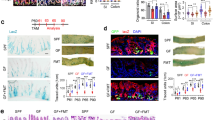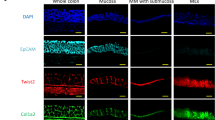Abstract
Diet can impact on gut health and disease by modulating intestinal stem cells (ISCs). However, it is largely unknown if and how the ISC niche responds to diet and influences ISC function. Here, we demonstrate that Lepr+ mesenchymal cells (MCs) surrounding intestinal crypts sense diet change and provide a novel niche signal to maintain ISC and progenitor cell proliferation. The abundance of these MCs increases upon administration of a high-fat diet (HFD) but dramatically decreases upon fasting. Depletion of Lepr+ MCs resulted in fewer intestinal stem/progenitor cells, compromised the architecture of crypt–villus axis and impaired intestinal regeneration. Furthermore, we showed that IGF1 secreted by Lepr+ MCs is an important effector that promotes proliferation of ISCs and progenitor cells in the intestinal crypt. We conclude that Lepr+ MCs sense diet alterations and, in turn, modulate intestinal stem/progenitor cell function via a stromal IGF1–epithelial IGF1R axis. These findings reveal that Lepr+ MCs are important mediators linking systemic diet changes to local ISC function and might serve as a novel therapeutic target for gut diseases.
Similar content being viewed by others
Log in or create a free account to read this content
Gain free access to this article, as well as selected content from this journal and more on nature.com
or
Data availability
The authors declare that all supporting data are available within the Article and its Supplementary Information files. 3ʹ-scRNA-seq data sets have been deposited in the Gene Expression Omnibus (GEO) database under the accession code: GSE165806. All generic and custom R, Python and MATLAB scripts are available on reasonable request.
References
Francescangeli, F., De Angelis, M. L. & Zeuner, A. Dietary factors in the control of gut homeostasis, intestinal stem cells, and colorectal cancer. Nutrients 11, 2936 (2019).
Alonso, S. & Yilmaz, O. H. Nutritional regulation of intestinal stem cells. Annu. Rev. Nutr. 38, 273–301 (2018).
Ocvirk, S., Wilson, A. S., Appolonia, C. N., Thomas, T. K. & O’Keefe, S. J. D. Fiber, fat, and colorectal cancer: new insight into modifiable dietary risk factors. Curr. Gastroenterol Rep. 21, 62 (2019).
Ruemmele, F. M. Role of diet in inflammatory bowel disease. Ann. Nutr. Metab. 68(Suppl 1), 33–41 (2016).
Shivashankar, R. & Lewis, J. D. The role of diet in inflammatory bowel disease. Curr. Gastroenterol. Rep. 19, 22 (2017).
Beyaz, S. et al. High-fat diet enhances stemness and tumorigenicity of intestinal progenitors. Nature 531, 53–58 (2016).
Weng, M. L. et al. Fasting inhibits aerobic glycolysis and proliferation in colorectal cancer via the Fdft1-mediated AKT/mTOR/HIF1alpha pathway suppression. Nat. Commun. 11, 1869 (2020).
O’Flanagan, C. H., Smith, L. A., McDonell, S. B. & Hursting, S. D. When less may be more: calorie restriction and response to cancer therapy. BMC Med. 15, 106 (2017).
Shoshkes-Carmel, M. et al. Subepithelial telocytes are an important source of Wnts that supports intestinal crypts. Nature 557, 242–246 (2018).
Degirmenci, B., Valenta, T., Dimitrieva, S., Hausmann, G. & Basler, K. GLI1-expressing mesenchymal cells form the essential Wnt-secreting niche for colon stem cells. Nature 558, 449–453 (2018).
Stzepourginski, I. et al. CD34+ mesenchymal cells are a major component of the intestinal stem cells niche at homeostasis and after injury. Proc. Natl. Acad. Sci. USA 114, E506–E513 (2017).
Greicius, G. et al. PDGFRalpha(+) pericryptal stromal cells are the critical source of Wnts and RSPO3 for murine intestinal stem cells in vivo. Proc. Natl. Acad. Sci. USA 115, E3173–E3181 (2018).
Wu, N. et al. MAP3K2-regulated intestinal stromal cells define a distinct stem cell niche. Nature 592, 606–610 (2021).
Holloway, E. M. et al. Mapping development of the human intestinal niche at single-cell resolution. Cell Stem Cell 28, 568–580.e4 (2021).
McCarthy, N. et al. Distinct mesenchymal cell populations generate the essential intestinal BMP signaling gradient. Cell Stem Cell 26, 391–402.e5 (2020).
Jarde, T. et al. Mesenchymal niche-derived neuregulin-1 drives intestinal stem cell proliferation and regeneration of damaged epithelium. Cell Stem Cell 27, 646–662.e7 (2020).
Park, H. K. & Ahima, R. S. Physiology of leptin: energy homeostasis, neuroendocrine function and metabolism. Metabolism 64, 24–34 (2015).
Asada, N. et al. Differential cytokine contributions of perivascular haematopoietic stem cell niches. Nat. Cell Biol. 19, 214–223 (2017).
DeFalco, J. et al. Virus-assisted mapping of neural inputs to a feeding center in the hypothalamus. Science 291, 2608–2613 (2001).
van der Flier, L. G., Haegebarth, A., Stange, D. E., van de Wetering, M. & Clevers, H. OLFM4 is a robust marker for stem cells in human intestine and marks a subset of colorectal cancer cells. Gastroenterology 137, 15–17 (2009).
Furuyama, K. et al. Continuous cell supply from a Sox9-expressing progenitor zone in adult liver, exocrine pancreas and intestine. Nat. Genet. 43, 34–41 (2011).
Hafemeister, C. & Satija, R. Normalization and variance stabilization of single-cell RNA-seq data using regularized negative binomial regression. Genome Biol. 20, 296 (2019).
Noris, M. & Remuzzi, G. Overview of complement activation and regulation. Semin. Nephrol. 33, 479–492 (2013).
Teixeira, A. L., Gama, C. S., Rocha, N. P. & Teixeira, M. M. Revisiting the role of eotaxin-1/CCL11 in psychiatric disorders. Front. Psychiatry 9, 241 (2018).
Lisignoli, G. et al. CXCL12 (SDF-1) and CXCL13 (BCA-1) chemokines significantly induce proliferation and collagen type I expression in osteoblasts from osteoarthritis patients. J. Cell Physiol. 206, 78–85 (2006).
Helfer, G. & Wu, Q. F. Chemerin: a multifaceted adipokine involved in metabolic disorders. J. Endocrinol. 238, R79–R94 (2018).
Bohin, N. et al. Insulin-like growth factor-1 and mTORC1 signaling promote the intestinal regenerative response after irradiation injury. Cell. Mol. Gastroenterol. Hepatol. 10, 797–810 (2020).
Jin, S. et al. Inference and analysis of cell-cell communication using CellChat. Nat. Commun. 12, 1088 (2021).
Sheng, X. et al. Cycling stem cells are radioresistant and regenerate the intestine. Cell Rep. 32, 107952 (2020).
Zhou, W., Rowitz, B. M. & Dailey, M. J. Insulin/IGF-1 enhances intestinal epithelial crypt proliferation through PI3K/Akt, and not ERK signaling in obese humans. Exp. Biol. Med. (Maywood) 243, 911–916 (2018).
Van Landeghem, L. et al. IGF1 stimulates crypt expansion via differential activation of 2 intestinal stem cell populations. FASEB J. 29, 2828–2842 (2015).
Matsumura, S. et al. Stratified layer analysis reveals intrinsic leptin stimulates cryptal mesenchymal cells for controlling mucosal inflammation. Sci. Rep. 10, 18351 (2020).
Sokolovic, M. et al. Fasting induces a biphasic adaptive metabolic response in murine small intestine. BMC Genomics 8, 361 (2007).
Mihaylova, M. M. et al. Fasting activates fatty acid oxidation to enhance intestinal stem cell function during homeostasis and aging. Cell Stem Cell 22, 769–778.e4 (2018).
Xie, Y. et al. Impact of a highfat diet on intestinal stem cells and epithelial barrier function in middleaged female mice. Mol. Med. Rep. 21, 1133–1144 (2020).
Qiao, C. et al. IGF1-mediated HOXA13 overexpression promotes colorectal cancer metastasis through upregulating ACLY and IGF1R. Cell Death Dis. 12, 564 (2021).
Murphy, N. et al. Circulating levels of insulin-like growth factor 1 and insulin-like growth factor binding protein 3 associate with risk of colorectal cancer based on serologic and mendelian randomization analyses. Gastroenterology 158, 1300–1312.e20 (2020).
Alexander, A. N. & Carey, H. V. Oral IGF-I enhances nutrient and electrolyte absorption in neonatal piglet intestine. Am. J. Physiol. 277, G619–G625 (1999).
Xu, J. et al. Secreted stromal protein ISLR promotes intestinal regeneration by suppressing epithelial Hippo signaling. EMBO J. 39, e103255 (2020).
Wolock, S. L., Lopez, R. & Klein, A. M. Scrublet: computational identification of cell doublets in single-cell transcriptomic data. Cell Syst. 8, 281–291.e9 (2019).
Stuart, T. et al. Comprehensive integration of single-cell data. Cell 177, 1888–1902.e21 (2019).
Guerrero-Juarez, C. F. et al. Single-cell analysis reveals fibroblast heterogeneity and myeloid-derived adipocyte progenitors in murine skin wounds. Nat. Commun. 10, 650 (2019).
Sato, T. et al. Single Lgr5 stem cells build crypt-villus structures in vitro without a mesenchymal niche. Nature 459, 262–265 (2009).
Sato, T. et al. Paneth cells constitute the niche for Lgr5 stem cells in intestinal crypts. Nature 469, 415–418 (2011).
Acknowledgements
This work is funded by grants from the National Key R&D Program of China (2021YFF1000603), the National Natural Science Foundation of China (82025006, 82000498, 82103115), SKLAB Open Grant (2022SKLAB6-03), the fellowship of China National Postdoctoral Program for Innovative Talents (BX20200369) and Plan111 (B12008). C.F.G.-J. is supported by UC Irvine Chancellor’s ADVANCE Postdoctoral Fellowship Program, NSF-Simons Postdoctoral Fellowship, and by a kind gift from the Howard Hughes Medical Institute Hanna H. Gray Postdoctoral Fellowship Program.
Author information
Authors and Affiliations
Contributions
Z.Y. and C.L. designed the experiments. M.D., C.L., X.S., J. Xu, X.Y., X.W., K.Y., M.L., G.L., J. Xiao performed research. C.F.G.-J. conceptualized and performed computational experiments and analysis. C.F.G.-J., X.L., K.W., F.R., Q.N., M.V.P., C.L. and Z.Y. analyzed the data. M.D., C.F.G.-J., C.L. and Z.Y. wrote the manuscript.
Corresponding authors
Ethics declarations
Competing interests
The authors declare no competing interests.
Rights and permissions
About this article
Cite this article
Deng, M., Guerrero-Juarez, C.F., Sheng, X. et al. Lepr+ mesenchymal cells sense diet to modulate intestinal stem/progenitor cells via Leptin–Igf1 axis. Cell Res 32, 670–686 (2022). https://doi.org/10.1038/s41422-022-00643-9
Received:
Accepted:
Published:
Issue date:
DOI: https://doi.org/10.1038/s41422-022-00643-9
This article is cited by
-
Dietary and metabolic effects on intestinal stem cells in health and disease
Nature Reviews Gastroenterology & Hepatology (2025)
-
Analysis of intracellular communication reveals consistent gene changes associated with early-stage acne skin
Cell Communication and Signaling (2024)
-
Megakaryocytic IGF1 coordinates activation and ferroptosis to safeguard hematopoietic stem cell regeneration after radiation injury
Cell Communication and Signaling (2024)
-
The role of IGF/IGF-1R signaling in the regulation of cancer stem cells
Clinical and Translational Oncology (2024)
-
Role of PDGFRA+ cells and a CD55+ PDGFRALo fraction in the gastric mesenchymal niche
Nature Communications (2023)



